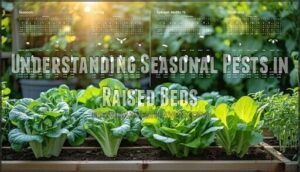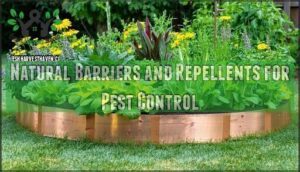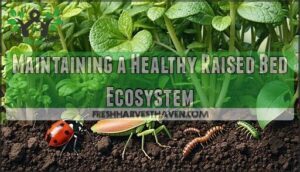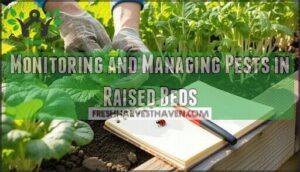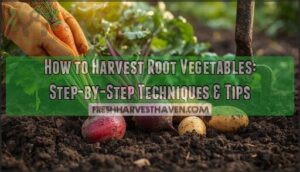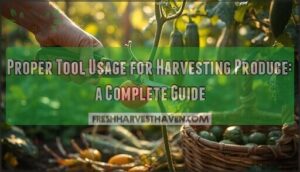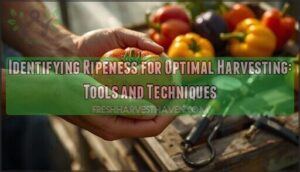This site is supported by our readers. We may earn a commission, at no cost to you, if you purchase through links.
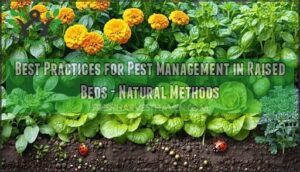 You’ll transform your raised bed into a pest-resistant fortress by mastering best practices for pest management in raised beds through natural methods.
You’ll transform your raised bed into a pest-resistant fortress by mastering best practices for pest management in raised beds through natural methods.
Start with companion planting—marigolds repel aphids while basil deters tomato hornworms. Install row covers during vulnerable growth stages, and scatter diatomaceous earth around susceptible plants.
Build beneficial insect habitats with native flowers to attract ladybugs and lacewings that’ll devour pests naturally. Practice crop rotation to break pest cycles, and maintain healthy soil through organic amendments since strong plants resist attacks better.
Regular monitoring catches problems early—check undersides of leaves weekly for eggs or damage. These prevention-focused strategies work better than reactive treatments, creating a balanced ecosystem where nature handles most pest control.
The real game-changer lies in understanding when and how to combine these methods for maximum effectiveness.
Table Of Contents
- Key Takeaways
- Effective Raised Bed Pest Management
- Understanding Seasonal Pests in Raised Beds
- Building a Pest-Resistant Raised Bed
- Natural Barriers and Repellents for Pest Control
- Organic Pest Control Methods for Raised Beds
- Strategic Planting Choices for Pest Prevention
- Installing Physical Barriers for Pest Prevention
- Maintaining a Healthy Raised Bed Ecosystem
- Monitoring and Managing Pests in Raised Beds
- Frequently Asked Questions (FAQs)
- Do raised beds keep pests away?
- Do raised garden beds attract pests?
- What pests are in a raised bed garden?
- How do you get rid of pests in a raised bed?
- How do I protect my garden bed from pests?
- How can I Keep my raised garden free of pests?
- How to protect a raised garden bed from pests?
- How to get rid of bugs in raised bed soil?
- What is the best pest control for vegetable garden?
- How to prevent pests in a vegetable garden?
- Conclusion
Key Takeaways
- Build a fortress with multiple defenses – You’ll get the best results by layering companion planting, physical barriers, and beneficial insect habitats rather than relying on single methods.
- Start with healthy soil as your foundation – You can prevent 60% of pest problems by maintaining organic soil amendments and proper pH levels that naturally strengthen plant resistance.
- Use prevention over reaction – You’ll save time and money by installing row covers, practicing crop rotation, and monitoring weekly instead of scrambling to treat infestations after they explode.
- Create a balanced ecosystem that works for you – You can let nature handle most pest control by attracting ladybugs and lacewings with native flowers while using companion plants like marigolds and basil to repel harmful insects.
Effective Raised Bed Pest Management
You can transform your raised bed into a pest-resistant fortress by combining beneficial predators, strategic companion planting, and physical barriers.
These natural methods work together to create a balanced ecosystem that controls pests without harmful chemicals.
Encouraging Beneficial Predators
Beyond attracting ladybugs and other beneficial insects, your raised bed’s success depends on creating the perfect environment for garden predators that naturally control pest populations.
These tiny allies establish ecosystem balance when you provide proper habitat conditions.
Transform your space into prime lacewing habitats with these proven predator attraction strategies:
Creating the perfect lacewing sanctuary means thinking like a beneficial predator—water, shelter, and native blooms within easy flight distance.
- Water stations – Place shallow dishes filled with pebbles and water near beds, creating safe drinking spots for beneficial insects that need constant moisture to survive and reproduce effectively.
- Shelter systems – Install bird houses for insect-eating species and construct toad shelters using overturned clay pots with entrance holes, providing safe havens for natural pest controllers.
- Native plant borders – Maintain strips of indigenous flowers and grasses around bed perimeters, offering nectar sources and overwintering sites for predatory mites and other beneficial species.
This approach creates garden ecosystem balance naturally, eliminating chemical dependency while building sustainable pest management.
Companion Planting for Pest Control
Companion planting transforms your raised bed into a natural pest control system where strategic plant partnerships defend your vegetables.
You’ll create aromatic pest control by interplanting fragrant herbs that confuse and repel harmful insects while attracting beneficials.
Planting combinations work through multiple mechanisms.
Basil’s strong scent masks tomato plants from hornworms, while marigolds release compounds that deter nematodes and aphids.
Nasturtiums serve as trap cropping decoys, luring aphids away from cucumbers and squash.
Repelling specific pests requires matching the right companion to your vulnerable crops:
| Companion Plant | Protected Crop | Target Pest |
|---|---|---|
| Basil | Tomatoes | Hornworms |
| Marigolds | Most vegetables | Aphids, nematodes |
| Nasturtiums | Cucumbers | Aphids, squash bugs |
| Garlic | Roses, peppers | Aphids, spider mites |
This organic pest control approach creates a self-defending ecosystem where beneficial insects thrive alongside your vegetables, reducing the need for interventions.
Many gardeners find that basil and oregano are effective together.
Physical Barriers for Pest Prevention
If you’ve already tried companion planting, it’s time to build a fortress. Physical barriers are your raised bed’s armor against pests.
These methods don’t rely on sprays or powders—they simply block pests from getting in. Here’s how to keep your crops safe:
- Hardware cloth uses: Bury hardware cloth at least 6 inches deep to stop tunneling rodents. Mesh size matters—choose ¼-inch mesh for best results.
- Row cover types: Use floating row covers to shield plants from flying insects while letting in sunlight and water.
- Copper tape effectiveness: Wrap copper tape around bed edges to create a no-go zone for slugs and snails.
- DIY fence designs: Install mesh fences to keep out rabbits and larger animals. Even a simple design adds serious pest prevention.
Layer these physical barriers for maximum protection against raised bed pests.
To further enhance your garden’s defenses, consider attracting beneficial insects. Your veggies will thank you!
Understanding Seasonal Pests in Raised Beds
You’ll encounter different pests throughout the growing season, and knowing when they’re most active helps you prepare targeted defenses.
Each pest follows predictable life cycles tied to temperature and daylight changes, making timing your countermeasures much more effective.
Identifying Common Garden Pests
Your pest identification guide starts with recognizing damage symptoms – aphids leave sticky honeydew and curling leaves, while caterpillars create irregular holes.
Monitoring techniques like visual inspection catch 80% of early infestations. Don’t confuse beneficial look-alikes with pests; ladybug larvae resemble tiny alligators but devour aphids.
Understanding pest life cycles helps time interventions perfectly. Common garden pests in raised bed gardening include spider mites causing stippled leaves and slugs leaving silver trails.
Vegetable garden pests vary by season, making proper garden pest identification your first defense against raised bed pests.
Life Cycle of Garden Pests
After identifying those troublesome invaders, understanding their pest life cycle becomes your most powerful tool for effective garden pest control.
Pest metamorphosis follows four distinct stages that you can target strategically. During egg development, most vegetable garden pests hide their offspring on leaf undersides or in soil crevices, with incubation lasting 3-10 days depending on temperature. The larval stages represent peak destruction—caterpillars and grubs can devour your plants within weeks while progressing through 3-6 growth phases. Pupation duration ranges from 5-14 days as insects transform inside protective casings, often hidden in soil or plant debris. Finally, adult behavior focuses on mating and egg-laying, with lifespans varying from days to weeks.
Here’s your strategic approach for raised bed pests:
- Target egg clusters before they hatch using beneficial predators like ladybugs
- Control larvae during their most destructive feeding period with organic methods
- Remove pupae from soil and debris when accessible
- Prevent adult reproduction using traps and barriers
Timing your pest management interventions correctly stops infestations before they explode throughout your garden.
Seasonal Pest Emergence Patterns
Understanding pest timing gives you the upper hand in raised bed gardening.
Spring pests like aphids emerge when temperatures hit 50°F, targeting tender seedlings.
Summer pests including Japanese beetles peak in midsummer heat.
Fall pests like cabbage loopers migrate as temperatures cool.
Winter pests such as deer browse desperately on remaining crops.
Regional variations affect these seasonal emergence patterns substantially.
Building a Pest-Resistant Raised Bed
Building a pest-resistant raised bed starts with healthy soil that naturally fights off garden invaders.
You’ll create this foundation through proper soil testing, organic amendments, and fostering beneficial microorganisms that keep your plants strong and resilient.
Importance of Soil Testing
The foundation of effective raised bed gardening starts with understanding what’s happening beneath the surface.
Soil testing reveals critical information about pH levels, nutrient deficiency, and soil composition that directly impacts your plants’ ability to resist pests.
When soil health is at its best, plants develop stronger natural defenses against invaders.
Think of testing as your garden’s diagnostic tool—it shows you exactly what your soil needs to thrive.
Microbial activity flourishes when nutrients are balanced, creating an environment where beneficial organisms outcompete harmful pests.
You’ll want to test every 2-3 seasons because conditions change with weather and plant uptake.
Heavy metals and improper pH levels can weaken plants, making them vulnerable to attacks.
Regular testing in your pest management strategy guarantees you’re building soil that naturally resists problems before they start.
Organic Soil Amendments
Quality soil amendments turn your raised beds into natural pest-fighting machines that work around the clock.
After testing reveals your soil’s baseline, you’ll know exactly which organic amendments pack the biggest punch against garden invaders.
Smart gardeners rely on these three powerhouse amendments:
These garden allies work harder than any chemical spray, building your defense system 24/7.
- Vermicompost benefits – These nutrient-rich worm castings boost soil microbes that outcompete harmful pathogens while strengthening plant immunity
- Mycorrhizal fungi – These microscopic partners form protective networks around roots, creating living shields against pest attacks
- Compost tea – Weekly applications flood your beds with beneficial organisms that naturally suppress pest populations
Organic mulching with quality materials feeds soil microbes year-round, creating an underground army of pest fighters.
When you layer these organic soil amendments properly, you’re building a living fortress that makes raised bed gardening easier and more productive.
To further boost soil health, consider implementing no-till methods to reduce soil disturbance.
This natural pest control approach delivers results that last seasons, not days.
Your plants develop stronger root systems and natural resistance when surrounded by thriving soil biology.
Smart organic pest management starts beneath the surface, where healthy soil creates healthy plants that pests simply can’t damage.
Creating a Thriving Soil Ecosystem
Beyond the surface of your raised bed lies a complex underground network that serves as your garden’s first line of defense against pests. The Soil Food Web operates like a natural security system, where beneficial microbes and fungi communicate through chemical signals to protect your plants from harmful invaders.
Building Microbial Diversity creates this protective ecosystem through strategic amendments. Organic Matter fuels the entire system, while proper Nutrient Cycling guarantees plants develop strong immune responses. Quality soil testing reveals what your ecosystem needs most.
Here’s how to supercharge your thriving soil ecosystem:
- Mix worm castings and kelp meal monthly for slow-release nutrition that feeds beneficial organisms
- Brew compost tea weekly to flood your soil with protective bacteria and fungi
- Layer organic mulch to improve Water Retention while feeding soil microbes continuously
Focus on healthy soil fundamentals rather than quick fixes. When you invest in organic soil amendments that build soil health, you’re creating an environment where beneficial organisms outnumber pests naturally, making chemical interventions unnecessary.
Natural Barriers and Repellents for Pest Control
Creating natural barriers and repellents gives you powerful tools to protect your raised beds without relying on harmful chemicals.
You’ll discover that simple materials like diatomaceous earth, carefully chosen pest-resistant varieties, and strategically placed traps work together to form an effective first line of defense against garden invaders.
This approach allows for a holistic method of garden protection, emphasizing the use of natural barriers to safeguard your plants.
Using Diatomaceous Earth
Against your garden’s biggest threats, diatomaceous earth acts like nature’s microscopic security system. This powder contains fossilized algae that creates razor-sharp barriers, slicing through Pest Exoskeletons and causing fatal dehydration in soft-bodied invaders.
DE Application success depends on choosing the right grade and timing. Always select food-grade DE Grades for raised bed gardening – industrial versions contain harmful additives. Understanding available product types is vital for effective pest control. Apply thin, even layers during dry conditions, since moisture neutralizes effectiveness.
Essential Safety Measures for diatomaceous earth use:
- Wear dust masks during application to protect respiratory health
- Store unused product in airtight containers to maintain potency
- Apply only during calm weather to prevent drift
- Reapply after rain or irrigation for continued protection
This organic pest control method excels against slugs, snails, aphids, and crawling insects while doubling as a beneficial Soil Amendment. The microscopic particles improve drainage and add trace minerals to your soil ecosystem. Unlike chemical alternatives, diatomaceous earth won’t harm beneficial insects when applied correctly, making it perfect for thorough garden pest control and pest management strategies.
Planting Pest-Resistant Seeds
Nobody starts a garden hoping to feed every pest in the neighborhood.
When you’re selecting certified seeds, you’re basically choosing plants that come with built-in security systems.
Look for seed variety labels featuring resistance codes like TMV for tobacco mosaic virus or PM for powdery mildew—these aren’t just fancy abbreviations, they’re your genetic resistance insurance policy.
Pestresistant seeds combined with proper seed treatment create a fortress your plants can live in comfortably.
Heirloom advantages include natural pest deterrence developed over generations, while modern hybrids offer targeted resistance breeding.
This approach to pest prevention in raised bed gardening beats reactive spraying every time.
Smart pest management starts before you even plant, making pest control about prevention rather than panic-driven responses later.
Installing Insect Traps
Strategic pest traps turn your raised beds into early warning systems. Position insect traps where they’ll catch problems before they explode into infestations.
- Trap Placement: Set sticky traps 2-3 inches above plant canopy for maximum exposure
- Trap Types: Use yellow for aphids and whiteflies, blue for thrips and cucumber beetles
- Bait Selection: Add pheromone lures for targeted species like cutworms or cabbage moths
- Monitoring Frequency: Check weekly to identify pest trends and population changes
- Trap Maintenance: Replace when surface becomes 75% covered or loses stickiness
Effective pest management starts with knowing what you’re fighting against. Consider using specialized raised bed traps for ideal results.
Organic Pest Control Methods for Raised Beds
When chemical sprays aren’t an option, organic pest control methods offer effective alternatives that work with nature’s own systems.
These targeted approaches tackle specific pest problems while protecting beneficial insects and maintaining your raised bed’s ecological balance.
Neem Oil and Insecticidal Soaps
While physical barriers provide excellent protection, neem oil and insecticidal soaps offer another layer of defense against soft-bodied pests in your raised beds.
These organic pest control methods work by suffocating insects and disrupting their feeding patterns.
Neem oil uses extend beyond immediate pest control—it prevents future infestations by interfering with insect reproduction cycles. Mix 2 tablespoons neem oil with 1 teaspoon mild liquid soap per quart of water.
For insecticidal soaps, combine 1 tablespoon pure castile soap with one quart water.
Soap application tips include spraying during cooler morning or evening hours to prevent leaf burn. Test spray a small area first since plant sensitivity varies.
Apply every 7-10 days for resistance management.
Homemade soap recipes work just as effectively as commercial products. Remember safe usage means avoiding beneficial insects like bees—spray when they’re less active.
Your raised bed gardening success depends on consistent, targeted applications.
Biological Control Agents
Three biological control agents transform your raised beds into self-defending ecosystems. These microscopic soldiers work continuously, targeting specific pests while preserving beneficial insects.
Deploy your natural pest control army:
- Release ladybugs at dusk – they’ll consume up to 5,000 aphids per season without flying away
- Apply beneficial nematodes to moist soil – these parasitic organisms reduce grubs by 80% in raised beds
- Plant nectar-rich flowers like yarrow – attracts parasitic wasps that increase predator visits by 30%
Microbial pesticides like Bacillus thuringiensis specifically target caterpillars, achieving 60-90% pest reduction in field trials. Consider using organic sprays like neem to further disrupt pest life cycles.
Conservation biocontrol through predator introduction creates augmentation strategies that maintain garden balance naturally, making your beds virtually pest-proof.
Hand-Picking Pests
Manual Pest Removal becomes your most precise pest control method in raised bed gardening. You’ll spot garden pests like hornworms and beetles during early morning inspections when they’re sluggish.
Handpicking Frequency matters—check daily during peak season. Identifying Pests correctly prevents removing beneficial insects.
Drop culprits into soapy water for disposal. Egg Removal from leaf undersides stops future infestations.
Tool Use isn’t necessary, but tweezers help with smaller pests. This pest management approach targets specific problems without chemicals.
Strategic Planting Choices for Pest Prevention
Smart plant selection creates the foundation for natural pest control in your raised beds.
When you choose the right combination of crops and arrange them strategically, you’re building a living defense system that works around the clock to keep harmful insects at bay.
Companion Planting
You’ll transform your raised bed into nature’s own security system by strategically pairing plants that naturally deter pests.
This companion planting approach creates powerful partnerships where aromatic herbs and flowers work together to confuse garden pests while supporting beneficial insects.
Smart plant combinations turn your garden into a pest-fighting fortress through natural chemical warfare.
Here’s how to build your plant defense network:
- Repel nematodes by planting marigolds around vulnerable vegetables like tomatoes and peppers.
- Attract pollinators with yarrow and sunflowers while deterring harmful insects simultaneously.
- Use decoy cropping by positioning nasturtiums to lure aphids away from cucumbers and squash.
- Create trap cropping stations with aromatic herbs like basil near tomatoes to confuse hornworms.
This raised bed gardening strategy maximizes pest management through natural plant chemistry, reducing your need for interventions while maintaining healthy soil ecosystems.
Crop Rotation
Smart crop rotation systematically disrupts pest cycles by moving plant families to different raised beds each season.
This family rotation confuses returning insects expecting their preferred hosts.
Your rotation benefits include improved soil health through varied nutrient management and reduced pest disruption.
Plan three-year cycles—nightshades, legumes, then brassicas—for effective pest prevention in raised beds.
Planting Different Crops Together
While crop rotation disrupts pest cycles across seasons, companion planting creates immediate protection by strategically combining different plants.
This intercropping approach leverages allelopathic effects where certain crops naturally repel pests through chemical compounds. Your polyculture design confuses insects that rely on visual and scent cues to locate host plants.
Polyculture farming offers remarkable intercrop benefits through resource partitioning:
- Marigolds release compounds that deter nematodes from attacking tomato roots
- Basil’s aromatic oils mask pepper scents, confusing aphids completely
- Nasturtiums act as trap crops, luring cucumber beetles away from main harvests
- Dill flowers attract parasitic wasps that eliminate harmful caterpillars naturally
- Garlic prevents fungal diseases through powerful antimicrobial properties
Beneficial insects thrive in diverse plantings, while yield maximization occurs when plants complement rather than compete for nutrients and space.
Installing Physical Barriers for Pest Prevention
Physical barriers offer your most reliable defense against garden pests without chemicals or complex maintenance routines.
You can create effective protection systems using simple materials like row covers, mesh fencing, and even repurposed household items to keep unwanted visitors away from your crops.
Using Row Covers
Following companion planting strategies, you’ll want to create physical barriers that complement your natural pest deterrence methods. Row covers offer exceptional pest exclusion while maintaining ideal growing conditions for your plants.
These lightweight fabric barriers block 95% of common garden pests while allowing sunlight and moisture to reach your crops. Material selection depends on your specific needs – lightweight spun fabric works best for general pest management, while heavier materials provide frost protection. Consider garden row covers for thorough plant protection.
| Cover Type | Pest Exclusion Rate | Seasonal Usage | Installation Methods |
|---|---|---|---|
| Lightweight Fabric | 95% flying insects | Spring through fall | Drape over hoops, secure edges |
| Medium Weight | 90% crawling pests | Cool season crops | Clip to bed frames |
| Heavy Duty | 85% larger pests | Winter protection | Anchor with sandbags |
Installation methods vary from simple draping to hoop systems. Secure edges with clips, stones, or soil to prevent pest entry. For microclimate control, remove covers during flowering to allow pollination, then reinstall for continued protection.
Installing Fencing and Mesh
Beyond row covers, fencing and mesh create permanent fortifications around your raised beds for pest management.
Hardware cloth stands as your first line of defense—bury it 6 inches deep with Installation Depth precision to block tunneling rodents, while extending 24-36 inches above ground for maximum Barrier Height.
Material Choice matters substantially. Select galvanized wire with quarter-inch Mesh Size openings, guaranteeing Pest Specificity against common garden invaders. Install sturdy posts every 4 feet to prevent sagging that compromises your barrier methods.
Consider these emotional victories when installing fencing and mesh:
- Your tomatoes finally safe from midnight rabbit raids
- Watching frustrated squirrels bounce off your impenetrable fortress
- Harvesting intact vegetables for the first time in years
- Sleeping soundly knowing your garden investment is protected
Regular inspections guarantee your barriers maintain their protective integrity throughout the growing season.
Creating a Barrier With Waste Materials
Beyond installing mesh and fencing, your household waste can create powerful barriers that stop garden pests in their tracks. Waste Material Barriers transform everyday items into effective Repurposed Garden Protection systems that save money while protecting your raised beds.
Coffee grounds scattered around bed edges repel ants and slugs in 70% of garden trials, while crushed eggshells create sharp surfaces that reduce slug damage by up to 40%. Wood chips from fallen branches provide lasting mulch barriers, and cardboard collars wrapped around plant stems block cutworms completely.
Your Upcycled Pest Control arsenal includes:
- Hair clippings spread around plants create scent barriers that deer won’t cross
- Aluminum foil strips reflect light to confuse and deter flying insects
- Used tea bags buried near roots release natural pest-deterring compounds
- Newspaper layers block crawling pest migration routes while decomposing into soil
These Sustainable Pest Defense methods work best when you maintain 2-3 inch thickness around vulnerable plants, creating Composting Barriers that protect while enriching your soil ecosystem.
Maintaining a Healthy Raised Bed Ecosystem
A healthy raised bed ecosystem acts as your first line of defense against pests, creating natural balance that keeps harmful insects in check while supporting beneficial organisms.
By maintaining proper garden hygiene and encouraging biodiversity, you’ll reduce pest pressure by up to 60% while building resilient soil that produces stronger, more pest-resistant plants.
Keeping The Garden Clean
Debris removal and weed control form your first line of defense against pest invasions in raised beds. Clear fallen leaves, plant scraps, and dead material that harbor insects and disease pathogens.
Tool sanitation between garden beds prevents cross-contamination, while glove sanitation stops you from spreading problems. Early watering allows surfaces to dry before nightfall, reducing fungal growth.
Regular garden cleanliness cuts overwintering pest habitats by 90%, making pest prevention your most effective pest control strategy for long-term pest management success.
Removing Sick Plants
While garden hygiene creates the foundation, removing sick plants acts as your pest management shield. Diseased plants broadcast "vacancy" signals that attract unwanted visitors faster than you’d expect.
Weekly scouting reveals the truth—yellowing leaves, suspicious spots, and drooping stems tell stories of trouble brewing. Disease identification becomes your superpower when you spot these warning signs early. Swift action prevents preventing spread throughout your raised beds.
Your removal strategy protects everything you’ve worked for:
- Tool disinfection between cuts stops pathogen hitchhikers from spreading chaos
- Disposal methods require bagging infected material—never let it touch your compost
- Soil sanitation around removal sites creates clean zones for healthy growth
Smart pest control means treating sick plants like contagious problems, because that’s exactly what they’re in your garden ecosystem.
Encouraging Beneficial Organisms
After removing diseased plants, you’ll want to create a thriving environment for beneficial organisms. Your raised bed becomes a magnet for garden predators when you establish proper habitat creation.
Plant insectary plants like yarrow and sweet alyssum around bed edges to attract pollinators and predatory insects. These natural pest control allies form the foundation of your soil food web, supporting organic pest control efforts against common garden pests.
| Beneficial Organism | Target Pest | Habitat Needs |
|---|---|---|
| Lady beetles | Aphids, scale insects | Yarrow, fennel, shallow water |
| Lacewings | Aphids, thrips | Sweet alyssum, dill, pollen sources |
| Ground beetles | Slugs, caterpillars | Mulch, stone borders, ground cover |
| Parasitic wasps | Caterpillars, aphids | Small flowers, consistent nectar |
This balanced ecosystem maintains effective pest management naturally, which is crucial for a healthy garden.
Monitoring and Managing Pests in Raised Beds
Successfully monitoring your raised bed means staying one step ahead of pest problems before they become major infestations.
You’ll catch issues early and prevent damage by using the right tools and keeping detailed records of what works in your garden, which involves staying one step ahead of problems and prevent damage.
Using Sticky Traps
Sticky traps transform your raised beds into early warning systems that catch flying pests before they multiply.
Color Matters when selecting these silent sentinels—yellow attracts aphids and whiteflies, while blue targets thrips.
Trap Placement at plant height maximizes effectiveness without hindering your gardening routine.
Trap Maintenance requires replacement every few weeks.
Here’s what makes sticky traps invaluable for pest management:
- Pest Identification becomes effortless when you see exactly what’s attacking your plants
- Monitoring Effectiveness helps track seasonal patterns and infestation severity
- Chemical-free pest control protects beneficial insects while catching harmful ones
- Peace of mind knowing your raised beds have 24/7 protection
Keeping a Pest Management Journal
While sticky traps capture flying pests, Record Keeping transforms your observations into actionable intelligence.
Your pest management journal becomes the foundation for early detection and integrated pest management success.
Document each pest identification, treatment applied, and results in your Treatment Tracking log:
Data Analysis reveals patterns—like aphids appearing after heavy rain—enabling Preventative Strategies instead of reactive scrambling.
This monitoring approach converts guesswork into precision pest control.
Frequently Asked Questions (FAQs)
Do raised beds keep pests away?
Raised beds don’t automatically keep pests away, but they do offer better control.
You’ll still need barriers like hardware cloth, row covers, and proper spacing to effectively manage most garden pests, using barriers to keep them away is essential.
Do raised garden beds attract pests?
Garden beds can attract certain pests like slugs, snails, and ground-dwelling insects due to mulch and organic matter, but they’re easier to monitor and protect than ground-level gardens.
What pests are in a raised bed garden?
Common raised bed pests include aphids, slugs, snails, cutworms, cabbage worms, whiteflies, spider mites, and root-dwelling grubs. You’ll also encounter larger invaders like rabbits, birds, and rodents targeting your crops.
How do you get rid of pests in a raised bed?
Start with physical barriers like row covers and copper tape, then introduce beneficial insects such as ladybugs. Apply organic methods like neem oil and diatomaceous earth for stubborn infestations.
How do I protect my garden bed from pests?
Like knights of old protecting their castles, you’ll defend your garden through multiple layers.
Install row covers, apply diatomaceous earth around plants, encourage beneficial insects with companion planting, and maintain proper spacing for airflow.
How can I Keep my raised garden free of pests?
You’ll keep pests away by practicing crop rotation, using row covers, planting companion plants like marigolds and basil, encouraging beneficial insects, and maintaining clean garden hygiene with proper spacing.
How to protect a raised garden bed from pests?
Create physical barriers like row covers and hardware cloth.
Use companion plants such as marigolds and basil.
Apply diatomaceous earth around beds.
Encourage beneficial insects through diverse plantings for natural pest control.
How to get rid of bugs in raised bed soil?
Transform your soil’s unwelcome residents into yesterday’s problem by introducing beneficial nematodes that target pest larvae.
Applying diatomaceous earth to dehydrate crawling insects is another approach to managing pests.
Maintaining proper drainage to discourage root-dwelling pests naturally is also crucial for a healthy soil environment.
What is the best pest control for vegetable garden?
Use integrated pest management combining beneficial insects, companion planting, physical barriers, and organic treatments. Encourage ladybugs and lacewings while deterring pests with marigolds and basil. Apply neem oil when needed.
How to prevent pests in a vegetable garden?
Start by selecting disease-resistant varieties and practicing crop rotation to disrupt pest cycles.
Maintain garden hygiene, space plants properly, and use companion planting with marigolds and basil to naturally repel unwanted insects.
Conclusion
Like a gardener tending a castle’s defenses, you’ve built multiple layers of protection that work together seamlessly.
These best practices for pest management in raised beds transform your garden into a self-regulating ecosystem where nature handles most problems before they escalate.
Your combination of companion planting, beneficial insect habitats, physical barriers, and healthy soil creates a fortress that’s both productive and resilient.
Remember, prevention beats treatment every time—these methods work because they address root causes rather than symptoms, giving you healthier plants and bigger harvests with less effort.
- https://eartheasy.com/insect-dust-diatomaceous-earth-4-4-lb
- https://www.ollegardens.com/blogs/olle-garden-tips/raised-garden-bed-gardening-pest-management?srsltid=AfmBOopPqi9_n94KXBTK7VF9-FxuZNxIaxQRgHdqkz1PLE10Wue1kcGq
- https://ipm.missouri.edu/meg/index.cfm?ID=344
- https://joegardener.com/podcast/raised-bed-gardening-pt-3-animal-control-more/
- https://www.reddit.com/r/ottawaplants/comments/1ajr282/advice_for_backyard_vegetable_garden_pests_and/


